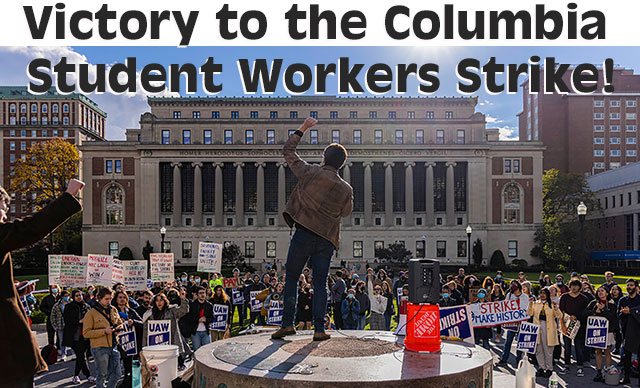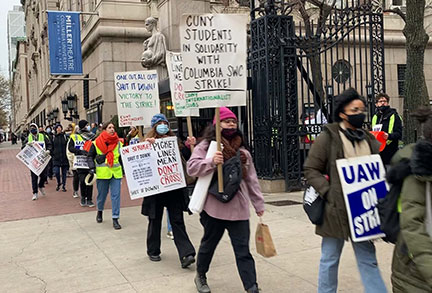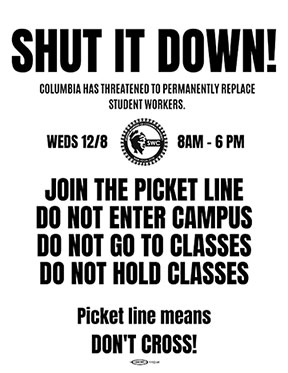December 2021
Against Bosses’ Threats and Maneuvers – Solidarity from CUNY

On the first day of the Columbia University student workers strike, Nov. 3. (Hiroko Masuike/The New York Times)
DECEMBER 28 – As we go to press, the strike of Student Workers of Columbia (part of United Auto Workers Local 2110), now in its ninth week, is at a critical juncture. It is the fourth strike in five years, as the union is still fighting to win a first-ever contract. Representing more than 3,000 Columbia University graduate and undergraduate academic employees (including instructors, teaching assistants, graders, researchers and others), the SWC’s demands include a living wage (many student workers who are paid hourly earn as little as $16 an hour, while those on an annual appointment currently make as little as $26,000 a year), better health care and measures against discrimination and harassment.
On December 23, the university presented its “best and final” contract proposal. The SWC noted that Columbia gave some ground on pay, healthcare and other issues. (Certainly, the university can’t plead poverty – its endowment grew more than 32% in fiscal 2021, to $14.35 billion.) Yet a central sticking point remains: the bosses’ insistence on excluding from the bargaining unit those who have less than 15 hours’ work per week or haven’t yet racked up 250 hours. The purpose is to further divide the workforce and incentivize reliance on grossly underpaid “casual” labor. Calling an online “Rally for Recognition” on December 30, a SWC spokesperson stated, “By creating a category of ‘casual’ workers who are excluded from the union, the administration will be able, over time, to replace union jobs with ‘casual,’ non-union jobs.”
Union activists rightly emphasize the need to oppose this union-busting scheme. The issue of full union recognition has been a central reason for the current strike from the beginning. Last May, in the previous strike, union members rejected, by a vote of 1,093 to 970, a deal with the university negotiated by the bargaining committee then in office. This was in large part because the proposed settlement would have “excluded hundreds of workers who have gone on strike and organized for this union,” as Joanna Lee, one of the three committee members who opposed it, tweeted at the time. (The Columbia Spectator [2 May] reported that “a graduate student union has never before rejected a tentative agreement.”)
 CUNY Internationalist
Clubs at December 8 Columbia picket. (Internationalist photo)
CUNY Internationalist
Clubs at December 8 Columbia picket. (Internationalist photo)To explicitly reflect its inclusion of undergraduate employees, the union changed its name from Graduate Workers of Columbia to Student Workers of Columbia. A new bargaining committee was elected in July, and in September the membership voted to authorize a new strike, which began on November 3. In this strike, as in the spring and in earlier strikes, activists from the CUNY Internationalist Clubs and Class Struggle Education Workers have participated intensively on the picket lines and in helping build support. In an important step, SWC members began seeking to stop deliveries to the struck campus, beginning in the predawn hours, and our comrades have participated in these efforts, which have sometimes met with success.
Throughout, we have emphasized that it’s essential to put into practice the principle that “Picket lines mean don’t cross.” To win a solid victory at Columbia, a pillar of New York’s capitalist elite, would require that all classes be cancelled and all sectors of the campus workforce brought out. (See the leaflet of the CUNY Internationalist Clubs and Revolutionary Internationalist Youth, “Solidarity from CUNY – All Out to Win: Victory to the Columbia Grad Workers Strike!” March 2021.) This means “One out, all out,” instead of the labor tops’ policy of keeping the rest of the workforce (including other units of UAW Local 2110) on the job.
As higher-education labor struggles continue to break out across the country, whatever happens at Columbia will be cited as a precedent. A solid victory here won’t be won with business-as-usual unionism. It would need to go well beyond Columbia’s academic “ivory tower” to bring in the power of NYC labor together with oppressed communities. In particular, black Harlem, just below Morningside Heights, has been forever lorded over by Columbia, whose flagrant racism sparked the historic strike of 1968.
The Struggle Escalates
On December 2, Columbia threatened to fire strikers (which would mean opening the way to their replacement by scabs) if they did not return to work by the 10th, a couple of days before final exams were due to begin. For the strikers, weeks of “one day longer” on the picket lines were stretching toward the end of the semester, bills were piling up, could they hold out? Columbia’s arrogant bosses thought they could finally break them.
Instead, strikers redoubled their determination, upping the ante. The elements of what’s needed to win were coming more sharply into focus for many – in particular, that picket lines really do mean don’t cross. A day of action was called and hundreds of union fliers were posted up calling to “SHUT IT DOWN” on Wednesday, December 8. (See graphic.) The Columbia Spectator (9 December) reported:
“On Wednesday, the Student Workers of Columbia-United Auto Workers held multiple picket lines blocking all entrances to Columbia’s Morningside campus from 8 a.m. to 6 p.m., asking students and faculty not to cross the picket lines in an effort to entirely shut down the campus. The student-workers were joined by faculty members, undergraduates, and members of other unions and labor organizations across New York City.”
 SWC leaflet for
Dec. 8 day of action to shut down Columbia.
SWC leaflet for
Dec. 8 day of action to shut down Columbia. Strikers and supporters linked hands, circling both sides of huge campus gates, holding official “On Strike” signs, and often large handmade ones. Early in the day at Columbia’s main entrance on Broadway and 116th Street, a prominent strike organizer, an Asian woman, was viciously shoved by a man who ostentatiously ripped up the large sign she was carrying, which read “ON STRIKE! SHUT IT DOWN! PICKET LINES MEAN DON’T CROSS!” Later at the same gate, an NYPD “Community Affairs” officer lunged suddenly and shoved picketers.
At a different entrance a scab violently barged into a young woman picketer from the CUNY Internationalist Clubs, who was knocked over backwards and would have hit the sidewalk had another picketer not caught her. Anti-strike aggressions multiplied as the day went on – but the Columbia administration, following the union-busters’ playbook, lyingly accused the strikers of “violence.”
On December 8, the situation varied from one place and time to another, and so did consciousness. It was notable that, repeatedly, where scabs violently busted through the picket lines, determined strike militants doubled down, seeking to uphold and defend this vital principle of labor struggle. But at some entrances pickets were porous, which undermines strike. The uneven consciousness reflects decades of union bureaucrats calling “informational” picket lines – a contradiction in terms which teaches people that it’s supposedly “OK” to cross picket lines. . But as hundreds of Columbia strikers linked hands in large pickets, blocking entrances and chanting “picket lines mean don’t cross,” many may have begun to see, for the first time, that once a strike has been collectively decided on, everyone must respect the lines. Generalizing and putting this into practice is crucial for the future of this and other struggles.
Outreach to a number of NYC labor sectors brought a lively contingent of Verizon workers from CWA Local 1101; officers and members of the CUNY faculty/staff union (PSC); some activists from DC37, unionized Legal Aid and legal services employees, and others. Most prominent was a truck from Teamsters Local 804, which represents UPS workers, bearing a huge inflatable “fat cat.” (This recalls how adjunct faculty at Sussex County Community College in New Jersey won their contract fight in a day back in 2009, when unionized truck drivers blocked all the entrances.) The Central Labor Council sent out an announcement of the SWC’s day of action. This was important, of course – though if the CLC were to actually mobilize to the picket lines even one or two thousand out of the 1.3 million workers it boasts of representing, it would be a whole different ballgame.
As in any strike, it’s about power. The strikers’ December 8 day of action to “Shut It Down” was a big step up in militancy, and certainly a crucial factor in getting the administration to move on some of the union’s key demands. With the new year around the corner, the strikers are sticking to their guns. They deserve and need the massive, militant solidarity that can help push this struggle over the finish line, forcing Columbia’s high-handed bosses to give in. A victory for the Columbia strikers would be a boost and an inspiration to workers and students everywhere, as we face the big challenges and opportunities ahead. ■
For a video about the Columbia University student workers strike, go to the Internationalist Group YouTube channel at https://www.youtube.com/watch?v=E-DVQ5HISwU&t=8s
